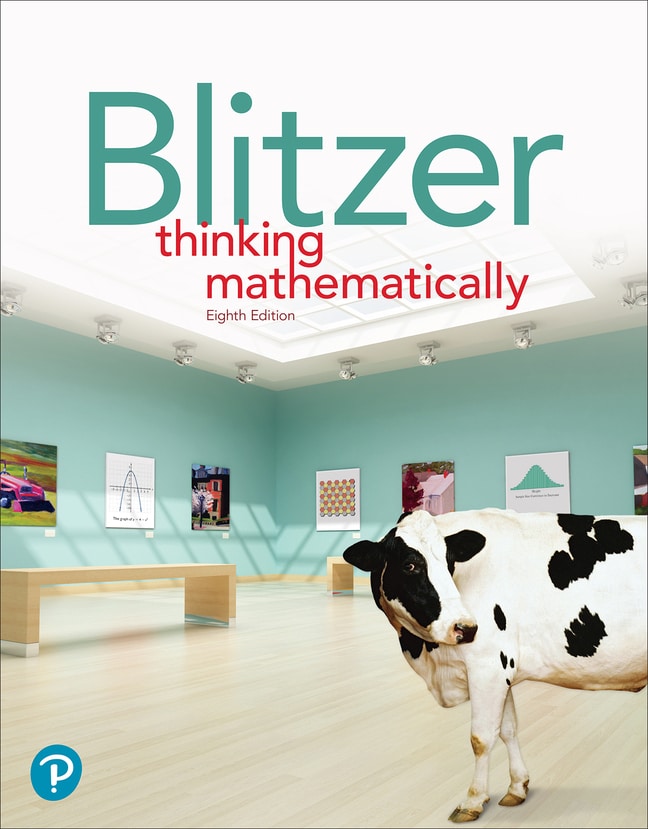
Thinking Mathematically, 8th edition
- Robert F. Blitzer

- Find it fast
Quickly navigate your eTextbook with search
- Stay organized
Access all your eTextbooks in one place
- Easily continue access
Keep learning with auto-renew
It's not always easy to see how math fits into everyday life. Designed for non-math majors, Thinking Mathematically uses diverse, interesting applications to show how truly relevant and fun math can be: the value of online classes, modeling coronavirus cases, the highest-paid celebrities, and many others. The 8th Edition updates its well-known exercises and examples with new topics and data, explores free online technology and resources, and much more. Blitzer's distinctive, relatable voice shows how our world is both mathematical and meaningful.
Published by Pearson (June 27th 2022) - Copyright © 2023
ISBN-13: 9780137551316
Subject: Liberal Arts Math
Category: Liberal Arts Math
(NOTE: Each chapter concludes with a Chapter Summary, Review, and Test.)
- Problem Solving and Critical Thinking
- 1.1 Inductive and Deductive Reasoning
- 1.2 Estimation, Graphs, and Mathematical Models
- 1.3 Problem Solving
- Set Theory
- 2.1 Basic Set Concepts
- 2.2 Subsets
- 2.3 Venn Diagrams and Set Operations
- 2.4 Set Operations and Venn Diagrams with Three Sets
- 2.5 Survey Problems
- Logic
- 3.1 Statements, Negations, and Quantified Statements
- 3.2 Compound Statements and Connectives
- 3.3 Truth Tables for Negation, Conjunction, and Disjunction
- 3.4 Truth Tables for the Conditional and the Biconditional
- 3.5 Equivalent Statements and Variations of Conditional Statements
- 3.6 Negations of Conditional Statements and De Morgan's Laws
- 3.7 Arguments and Truth Tables
- 3.8 Arguments and Euler Diagrams
- Number Representation and Calculation
- 4.1 Our Hindu-Arabic System and Early Positional Systems
- 4.2 Number Bases in Positional Systems
- 4.3 Computation in Positional Systems
- 4.4 Looking Back at Early Numeration Systems
- Number Theory and the Real Number System
- 5.1 Number Theory: Prime and Composite Numbers
- 5.2 The Integers; Order of Operations
- 5.3 The Rational Numbers
- 5.4 The Irrational Numbers
- 5.5 Real Numbers and Their Properties; Clock Addition
- 5.6 Exponents and Scientific Notation
- 5.7 Arithmetic and Geometric Sequences
- Algebra: Equations and Inequalities
- 6.1 Algebraic Expressions and Formulas
- 6.2 Linear Equations in One Variable and Proportions
- 6.3 Applications of Linear Equations
- 6.4 Linear Inequalities in One Variable
- 6.5 Quadratic Equations
- Algebra: Graphs, Functions, and Linear Systems
- 7.1 Graphing and Functions
- 7.2 Linear Functions and Their Graphs
- 7.3 Systems of Linear Equations in Two Variables
- 7.4 Linear Inequalities in Two Variables
- 7.5 Linear Programming
- 7.6 Modeling Data: Exponential, Logarithmic, and Quadratic Functions
- Personal Finance
- 8.1 Percent, Sales Tax, and Discounts
- 8.2 Income Tax
- 8.3 Simple Interest
- 8.4 Compound Interest
- 8.5 Annuities, Methods of Saving, and Investments
- 8.6 Cars
- 8.7 The Cost of Home Ownership
- 8.8 Credit Cards
- Measurement
- 9.1 Measuring Length; The Metric System
- 9.2 Measuring Area and Volume
- 9.3 Measuring Weight and Temperature
- Geometry
- 10.1 Points, Lines, Planes, and Angles
- 10.2 Triangles
- 10.3 Polygons, Perimeter, and Tessellations
- 10.4 Area and Circumference
- 10.5 Volume and Surface Area
- 10.6 Right Triangle Trigonometry
- 10.7 Beyond Euclidean Geometry
- Counting Methods and Probability Theory
- 11.1 The Fundamental Counting Principle
- 11.2 Permutations
- 11.3 Combinations
- 11.4 Fundamentals of Probability
- 11.5 Probability with the Fundamental Counting Principle, Permutations, and Combinations
- 11.6 Events Involving Not and Or; Odds
- 11.7 Events Involving And; Conditional Probability
- 11.8 Expected Value
- Statistics
- 12.1 Sampling, Frequency Distributions, and Graphs
- 12.2 Measures of Central Tendency
- 12.3 Measures of Dispersion
- 12.4 The Normal Distribution
- 12.5 Problem Solving with the Normal Distribution
- 12.6 Scatter Plots, Correlation, and Regression Lines
- Voting and Apportionment
- 13.1 Voting Methods
- 13.2 Flaws of Voting Methods
- 13.3 Apportionment Methods
- 13.4 Flaws of Apportionment Method
- Graph Theory
- 14.1 Graphs, Paths, and Circuits
- 14.2 Euler Paths and Euler Circuits
- 14.3 Hamilton Paths and Hamilton Circuits
- 14.4 Trees
Answers to Selected Exercises
Credits
Subject Index